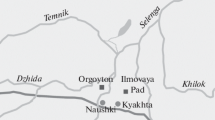Abstract
This paper reports the scientific investigation of a lacquer fragment unearthed from Barrow No. 7 in the Tsaram Xiongu cemetery. This lacquerware has an inscription suggesting that it was made in the Western Han Kao Gong workshop. Microscopic observation can determine that the foundation of this ware is composed of a mixture of lacquer, bone particles, and colorless minerals. It also has a layer of silk fabric, indicating its production for Han imperial use.










Similar content being viewed by others
References
Okada, Fumio 岡田文男. 1995. Kodai shutsudo shikki no kenkyu: Kenbikyō de saguru zaishitu to gihō 古代出土漆器の研究: 顯微鏡で探る材質と技法 (A study of excavated ancient lacquerware: microscopic investigations of materials and techniques). Kyōtō: Kyōtō Shoin.
Okada, Fumio. 2000. A study on the structure of the coating film of urushiware at the Linden-Museum, Stuttgart. In Japanese and European lacquerware, ed. Michael Kühlenthal, 135–148. München: Bayerisches Landesamt für Denkmalpflege.
Okada, Fumio. 2005. Kōgaku kenbikyo ni yoru kinu sen’i danmen no kansatuhō 光學顯微鏡による絹纖維断面の觀察法 (studies on silk-fiber cross-sections by optical microscopy). In Kinu bunkazai no sekai 絹文化財の世界 (the world of silk cultural properties), 132–135. Tōkyō: Kadokawa Gakugei Shuppan.
Okada, Fumio (trans. By Wang Yuanlin 王元林). 2013. Zhongguo gu dai qi qi cai zhi yu ji fa de xian wei jing guan cha 中國古代漆器材質與技法的顯微鏡觀察 (the materials and techniques of the Chinese ancient lacquer ware and their microscopy). In Haidai kao gu 海岱考古 6: 476-492. Beijing: Science Press.
Okada, Fumio 岡田文男, Ota Aki 太田亞希, Ping Jian 憑健, Shao Zhenyu 邵振宇, Jin Lan 金蘭, and Chen Bin 陳斌. 2009. Xi’an di qu Han mu chu tu jian (dao) qiao de fen xi yan jiu 西安地區漢墓出土劍(刀)鞘的分析研究 (analysis of the scabbard of the sword unearthed from the Han grave the Xi’an area). In Xi’an shi wen wu bao hu kao gu suo 西安市文物保護考古所 (editor), Xi’an Dong Han mu 西安東漢墓 (eastern Han tombs of Xi’an), 1077–1110. Beijing: Wen wu chu ban she.
Otani, Ikue. 2019. A reconsideration of a Chinese inscription carved on lacquerware unearthed from Barrow No. 7 of the Tsaram Xiongnu cemetery (Buryatia, Russia): new reflections on the organization of the central workshops of the Han. Asian Archaeology XX (X): XX–XX. https://doi.org/10.1007/s41826-019-00025-y.
Pirazzoli-t’Serstevens, Michèle. 2007. A Chinese inscription from a Xiongnu elite barrow in the Tsaram cemetery. In The Silk Road 5 (1): 56-58. Saratoga: The Silkroad Foundation.
Acknowledgements
The author would like to thank Professor Sergei Stepanovich Miniaev from the Institute of the History of Material Culture, Russian Academy of Science, for giving him the opportunity to investigate this lacquered object from Barrow No. 7 in the Tsaram Xiongu Cemetery, Russia.
Author information
Authors and Affiliations
Corresponding author
Rights and permissions
About this article
Cite this article
Okada, F. A scientific investigation of lacquer ware incised KaoGong: Excavated from barrow No.7, Tsaram Xiongnu cemetery. asian archaeol 3, 71–74 (2020). https://doi.org/10.1007/s41826-019-00026-x
Received:
Accepted:
Published:
Issue Date:
DOI: https://doi.org/10.1007/s41826-019-00026-x




